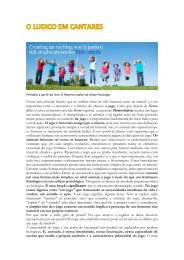Motherhood in Childhood
You also want an ePaper? Increase the reach of your titles
YUMPU automatically turns print PDFs into web optimized ePapers that Google loves.
has learned a number of lessons about comprehensive<br />
sexuality education. One is that<br />
even <strong>in</strong> the face of the HIV/AIDS pandemic,<br />
governments have been slow to implement<br />
comprehensive sexuality education, and even<br />
slower to reach the most vulnerable young<br />
people (Haberland and Rogow, 2013).<br />
A second lesson is that comprehensive sexuality<br />
education can be effective beyond the<br />
prevention of high-risk behaviours. Research<br />
shows that programmes that tend to have the<br />
greatest impact on adolescent pregnancy and<br />
sexually transmitted <strong>in</strong>fections are those that<br />
emphasize critical th<strong>in</strong>k<strong>in</strong>g about gender and<br />
power <strong>in</strong> relationships (Haberland and Rogow,<br />
2013). These f<strong>in</strong>d<strong>in</strong>gs offer promise for a new<br />
generation of programmes that can have a<br />
concrete, positive impact on the well-be<strong>in</strong>g<br />
of young people.<br />
New research shows that comprehensive sexuality<br />
education programmes are more likely to<br />
have an impact on reduc<strong>in</strong>g adolescent pregnancy<br />
and sexually transmitted <strong>in</strong>fections when<br />
they address gender and power issues. Studies<br />
from both develop<strong>in</strong>g and developed countries<br />
confirm that young people who believe <strong>in</strong> gender<br />
equality have better sexual health outcomes<br />
than their peers. In contrast, those young<br />
people who hold less egalitarian attitudes<br />
tend to have worse sexual health outcomes<br />
(International Sexuality and HIV Curriculum<br />
Work<strong>in</strong>g Group, 2011).<br />
Gender equality and human rights are key to<br />
prevent<strong>in</strong>g the spread of HIV and to enabl<strong>in</strong>g<br />
young people to grow up to enjoy good health.<br />
For example, young people who, compared to<br />
their peers, adopt egalitarian attitudes about<br />
gender roles are more likely to delay sexual<br />
debut, use condoms, and practice contraception;<br />
they also have lower rates of sexually<br />
transmitted <strong>in</strong>fections and un<strong>in</strong>tended pregnancy<br />
and are less likely to be <strong>in</strong> relationships<br />
characterized by violence. Another study found<br />
that a targeted programme to <strong>in</strong>crease girls’<br />
understand<strong>in</strong>g of the risks of <strong>in</strong>tergenerational<br />
sex reduced pregnancy by 28 per cent (Dupas,<br />
2011).<br />
Most comprehensive sexuality education<br />
is delivered through school-based curricula.<br />
However, not all adolescents attend school and<br />
not all rema<strong>in</strong> <strong>in</strong> school until they <strong>in</strong>itiate sex.<br />
Married girls between the ages of 10 and 14<br />
and who are not <strong>in</strong> school thus have virtually<br />
no access to sexuality education. It is therefore<br />
important to make additional efforts to meet<br />
the needs of adolescents who are out of school.<br />
Curriculum- and group-based sexuality and<br />
HIV education programmes can reach those<br />
who are not <strong>in</strong> school if they are implemented<br />
by providers of health and other services for<br />
youth, community centres, or other local<br />
<strong>in</strong>stitutions accessible to adolescents (Kirby<br />
et al., 2006).<br />
Accord<strong>in</strong>g to UNESCO (2013), 57 million<br />
children of primary school age and 69 million<br />
children of lower-secondary school age do not<br />
attend school. Most of them live <strong>in</strong> develop<strong>in</strong>g<br />
countries, and slightly more than half<br />
are girls. Two approaches with potential for<br />
reach<strong>in</strong>g large numbers of out-of-school adolescents—although<br />
not necessarily as stand-alone<br />
programmes for prevent<strong>in</strong>g pregnancy—<strong>in</strong>volve<br />
the use of the mass media and <strong>in</strong>teractive radio<br />
<strong>in</strong>struction.<br />
Recent reviews of mass media campaigns that<br />
promoted adolescent sexual health, mostly <strong>in</strong><br />
develop<strong>in</strong>g countries, found that they commonly<br />
<strong>in</strong>creased knowledge, and the majority<br />
THE STATE OF WORLD POPULATION 2013<br />
67

















